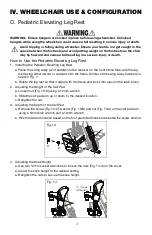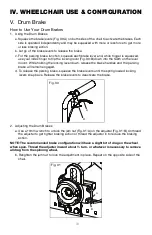
37
IV. WHEELCHAIR USE & CONFIGURATION
W. Anti-Tips
WARNING: Always keep anti-tips in the down position when they are not at risk of
interference. Have a clinical or technical professional confirm your anti-tips are installed in
the correct position. They can do so by tipping the occupied wheelchair back on to the
anti-tips to test that they properly limit the rearward rotation of your wheelchair. If the anti-
tips allow your wheelchair to tip to a point where your center of gravity (COG) is vertically
aligned with the point where the wheel contacts the ground, the wheelchair is unstable
and could result in the wheelchair tipping over. Tipping over could result in damage to
your wheelchair, serious injury or death.
•
New and experienced wheelchair users switching to a new wheelchair or adjusting
the configuration of a current wheelchair should always use anti-tips. If the user has
a change in physical capabilities, they should use anti-tips as well. Any change in
the user’s physical capabilities or wheelchair increases the risk of tipping over
backwards. Tipping over backwards could result in damage to your wheelchair,
serious injury or death. You should always use anti-tips until you have adapted to
the new or adjusted wheelchair.
•
Remove or turn the anti-tips up when ascending or descending curbs, obstacles
and steps. If the anti-tips are left in the down position when ascending or
descending curbs, obstacles and steps, they can become bent or broken. If the
anti-tips are bent or broken, they will no longer prevent the wheelchair from tipping
over backwards. Tipping over backwards could result in damage to your
wheelchair, serious injury or death.
•
Using your wheelchair on soft surfaces (including but not limited to sand, loose soil,
grass and gravel), uneven grades and ramps can cause anti-tips to lose
effectiveness resulting in the wheelchair tipping over backwards. Tipping over
backwards could result in damage to your wheelchair, serious injury or death.
•
Ki mobility recommends using two anti-tips on your wheelchair. Use of a single
anti-tip increases the risk of tipping over backwards. Tipping over backwards could
result in damage to your wheelchair, serious injury or death.
Ki Mobility recommends using anti-tips with your wheelchair. Anti-tips help prevent your
wheelchair from tipping over backwards. When adjusted properly, anti-tips provide a significant
increase in rearward stability. Use of anti-tips does not guarantee your wheelchair will not tip
over. Always remember to reinstall or turn the anti-tips to the down position after they were
removed or turned to the up position.
If anti-tips are set too short they won’t prevent the
wheelchair from tipping backwards.
Anti-tips are not meant to bear the weight of the
occupant for extended periods of time.
Fig. 32
Содержание Focus CR
Страница 1: ...2021 03 11...
Страница 47: ...2021 03 11...
Страница 97: ......
Страница 98: ......
Страница 99: ......
Страница 100: ...Ki Mobility 5201 Woodward Drive Stevens Point Wisconsin 54481 715 254 0991 www kimobility com DCN0255 0...
















































